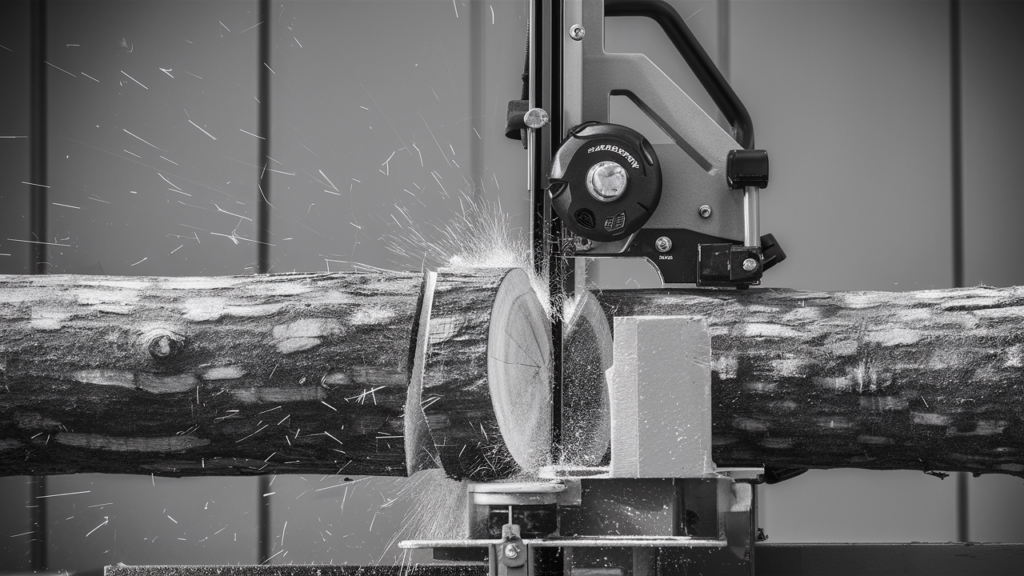Yes, a wood bandsaw can be used to cut metal with the appropriate metal-cutting blade. However, it’s important to note that using a wood bandsaw to cut metal requires a metal-cutting blade and adjustments to the bandsaw’s speed and settings to ensure safe and effective cutting.
When it comes to cutting metal, wood bandsaws can be a viable option with the right blade and adjustments. Many wood bandsaw users have successfully cut metal by equipping their bandsaws with metal-cutting blades and making necessary speed and setting adjustments.
However, it’s crucial to exercise caution and follow safety guidelines when using a wood bandsaw for metal cutting. In this blog, we’ll explore the considerations and modifications needed to use a wood bandsaw for cutting metal, as well as the benefits and potential challenges of this approach.
The Possibility Of Cutting Metal With A Wood Bandsaw
Wood bandsaws have been traditionally used for woodworking projects, but can they cut metal? The answer is yes, but with certain limitations. The basic concept behind cutting metal with a wood bandsaw is that the blade used for cutting wood can be replaced with a metal cutting blade. However, it is important to note that metal cutting blades have finer teeth and are designed to handle the hardness of metal. Comparing wood and metal bandsaws, metal-cutting band saw blades have more teeth, making them better for larger cuts when working with metal. Wood-cutting band saw blades, on the other hand, have fewer teeth, making them ideal for softer materials like wood. It is not recommended to use a wood cutting blade for metal as it may cause blade fatigue and damage due to the hardness of metal.
Essential Modifications For Metal Cutting
While a wood bandsaw can technically cut metal, it’s not recommended due to high speed and blade wear. Essential modifications like using metal-cutting blades and adjusting speed can help, but it’s best to use a metal bandsaw for efficient and precise results.
| Adjusting the bandsaw speed: | Reducing bandsaw speed is crucial for cutting metal accurately without damaging the blade. |
| Choosing the right blade: | Select a metal-cutting blade with finer teeth for smoother cuts on tougher materials. |
Step-by-step Guide To Converting Your Bandsaw
Convert your wood bandsaw to cut metal with a step-by-step guide. Discover how to adjust speed and install a metal cutting blade for efficient metalwork. Explore the possibilities of repurposing your bandsaw for versatile cutting tasks.
| Installing a speed controller |
| Fitting a metal cutting blade |
If you’re wondering whether a wood bandsaw can be used to cut metal, the answer is yes, with some modifications. Converting your bandsaw for metal cutting involves a few steps. First, you need to install a speed controller to adjust the speed of the blade. This is important because cutting metal requires slower speeds than cutting wood. Next, you’ll need to fit a metal cutting blade onto your bandsaw. Metal cutting blades have finer teeth and are designed to handle the hardness and strength of metal. By following these steps, you can transform your wood bandsaw into a tool that can effectively cut metal.
Safety Precautions And Tips
When using a wood bandsaw to cut metal, it is important to take certain safety precautions and follow some tips to ensure a smooth and safe operation.
Understanding blade tension: Before starting the cutting process, make sure the blade tension is properly adjusted. This will ensure that the blade stays in place and cuts smoothly through the metal.
Proper material support: When cutting metal on a wood bandsaw, it is essential to provide adequate support for the material. Use a sturdy workbench or table to hold the metal securely in place during the cutting process.
Using the right blade: While wood-cutting bandsaw blades can be used to cut metal, it is recommended to use a metal-cutting blade for better results. Metal-cutting blades have finer teeth and are specifically designed for cutting through metal.
Regular blade maintenance: To ensure optimal performance, regularly inspect and clean the blade. Replace any dull or damaged blades to maintain efficient cutting.
Protective gear: Always wear appropriate protective gear, including safety glasses and gloves, when operating a wood bandsaw to cut metal. This will protect you from any potential hazards or injuries.
The Versatility Of Bandsaws: From Wood To Metal
Unlocking the versatility of bandsaws, a wood bandsaw can indeed be used to cut metal. By installing a metal cutting blade, it’s possible to achieve precise cuts on various metals, showcasing the adaptability of this tool across different materials.
Bandsaws are an essential tool in any workshop, offering the versatility to cut through a variety of materials. While traditionally associated with woodcutting, bandsaws can also be used to cut metal. However, it is important to note that using a wood bandsaw to cut metal requires a metal-cutting blade with finer teeth to ensure a clean cut. It is not recommended to use a wood-cutting blade for cutting metal as it can cause damage to the blade and lead to blade fatigue. Additionally, some wood bandsaws may not have the power needed to cut through thicker metal materials. To expand your tool’s capabilities, consider investing in a metal-cutting blade or a dedicated metal bandsaw.
Case Studies: Successful Metal Cuts With A Wood Bandsaw
Using a wood bandsaw to cut metal is possible. Cutting aluminum can be achieved with the right blade and speed. When it comes to handling steel, it requires careful control and slower cutting speeds. Converting a wood bandsaw for metal cutting involves installing a speed controller to adjust the blade speed. Metal-cutting bandsaw blades have finer teeth, whereas wood-cutting blades have fewer teeth. It’s not recommended to put a metal cutting blade on a wood bandsaw due to the risk of blade fatigue and damage. Metal is harder and requires sharper, heavy-duty blades. Wood bandsaws run at slower speeds compared to metal bandsaws, which is crucial for successful metal cuts.
Maintenance And Blade Care
Wood bandsaws are not designed to cut metal due to their high speed. Attempting to use a wood bandsaw for metal cutting can result in blade fatigue and damage. Metal cutting blades are sharper and heavier duty to handle the hardness of metal, unlike wood-cutting blades.
| Using a wood bandsaw to cut metal requires routine checks for optimal performance. Maintenance and blade care are crucial for extending blade life. It’s important to inspect the blade regularly for any signs of wear and tear. Cleaning the blade after each use can help prevent corrosion and damage. Proper tensioning of the blade is essential for accurate cuts. Investing in high-quality blades can also improve cutting precision and efficiency. Following these maintenance tips can help maximize the lifespan of your wood bandsaw blades when cutting metal. |

Frequently Asked Questions
Can Wood Band Saws Cut Metal?
Yes, wood band saws can cut metal, but it is not recommended. Metal requires sharper and heavy-duty blades to complete cuts, and wood-cutting band saw blades typically have coarser blades with fewer teeth. Using a wood band saw to cut metal can cause blade fatigue and damage.
Metal-cutting band saw blades are better suited for larger cuts when working with metal.
What Is The Difference Between A Wood Bandsaw And A Metal Bandsaw?
The main difference between a wood bandsaw and a metal bandsaw is the type of blade they use. Metal-cutting bandsaw blades have more teeth and are finer, making them suitable for larger cuts in metal. Wood-cutting bandsaw blades have fewer teeth and are coarser, making them ideal for cutting softer materials.
It is not recommended to use a wood bandsaw to cut metal as it can cause blade fatigue and damage.
Can I Put A Metal Blade On A Wood Bandsaw?
No, it is not recommended to put a metal blade on a wood bandsaw. Using a wood bandsaw to cut metal can cause blade fatigue and damage. Metal requires sharper and heavy-duty blades to make clean cuts, while wood blades are designed for softer materials.
It is best to use the appropriate tool for each material.
Can You Use A Wood Cutting Saw For Metal?
Using a wood cutting saw for metal is not recommended. Metal requires sharper, heavy-duty blades due to its hardness compared to wood.
Conclusion
To conclude, using a wood bandsaw to cut metal is possible but not recommended. While it may work for thinner and softer metals, it poses risks such as blade fatigue and damage. Metal-cutting bandsaw blades are specifically designed for the hardness and strength of metal, making them more suitable for accurate and efficient cuts.
Therefore, it is advisable to use a metal-cutting bandsaw for cutting metal to ensure safety and optimal results.








